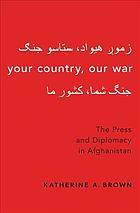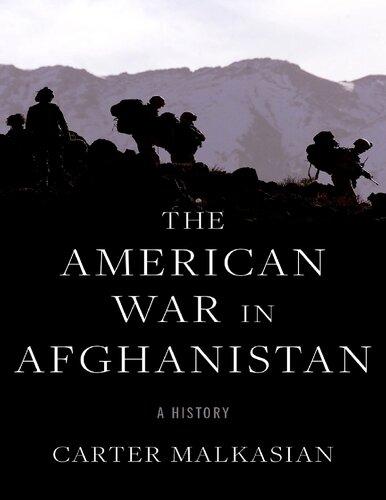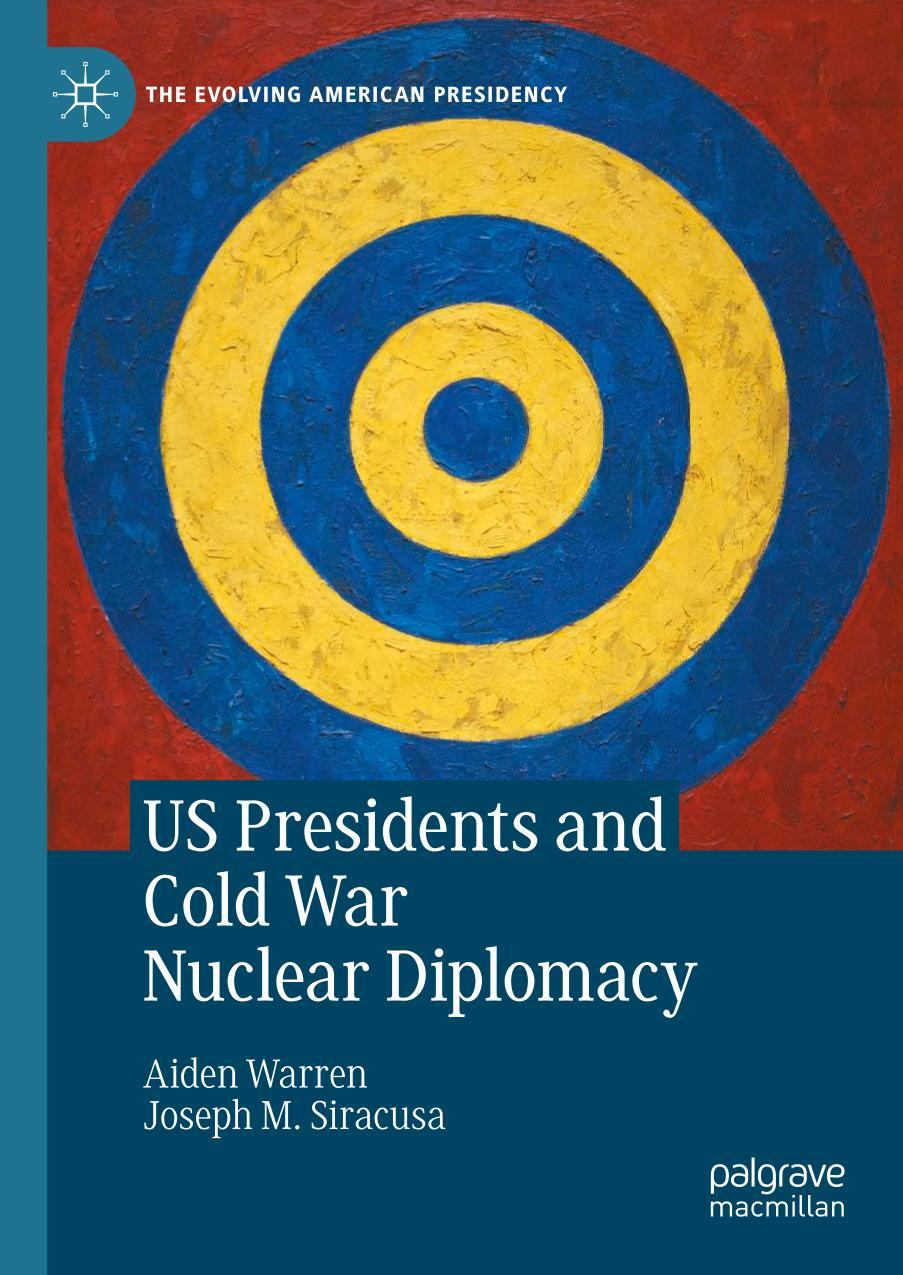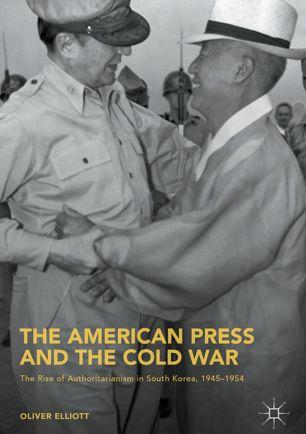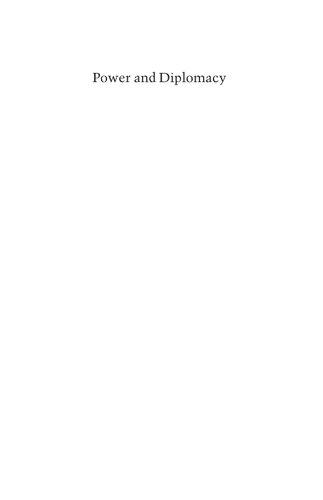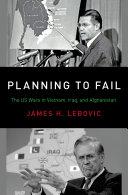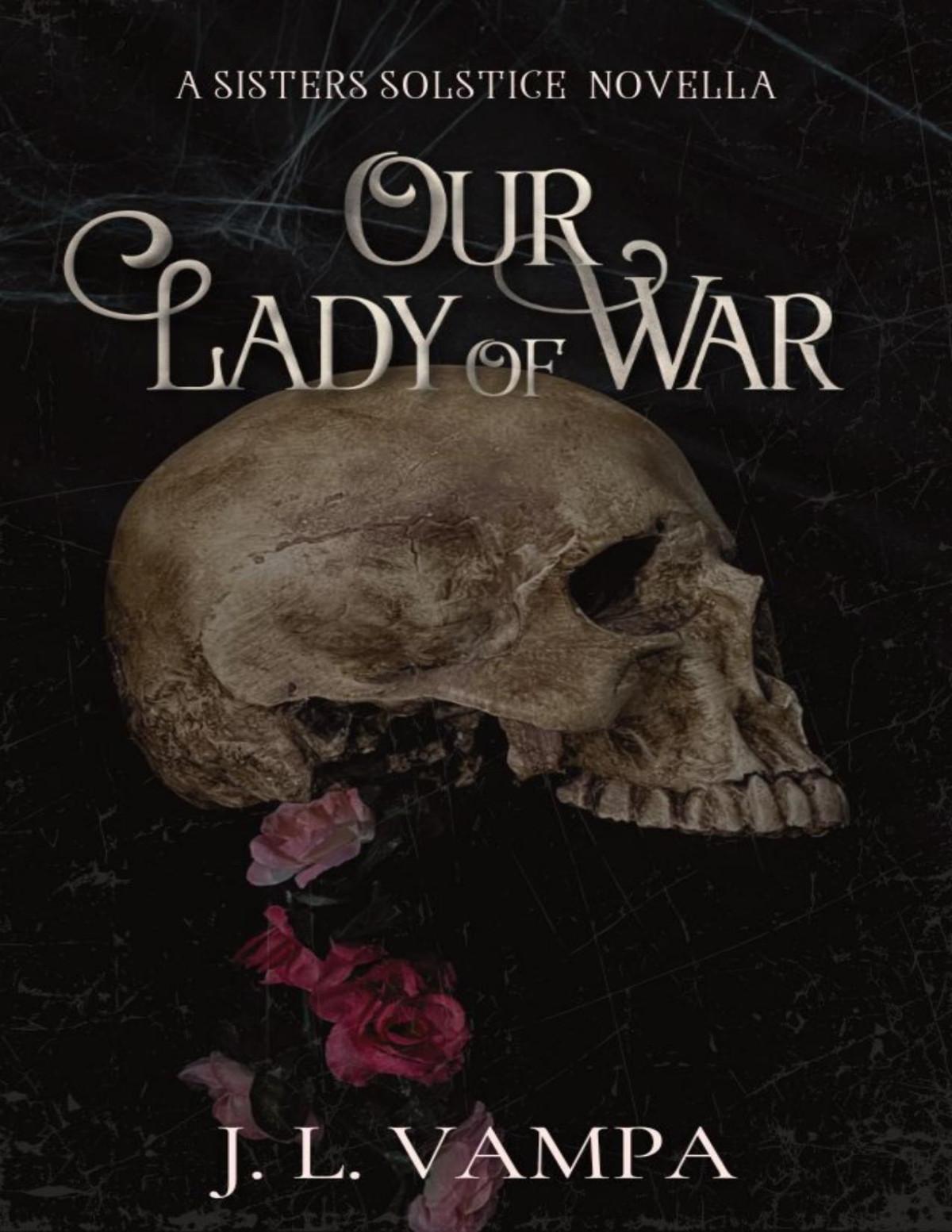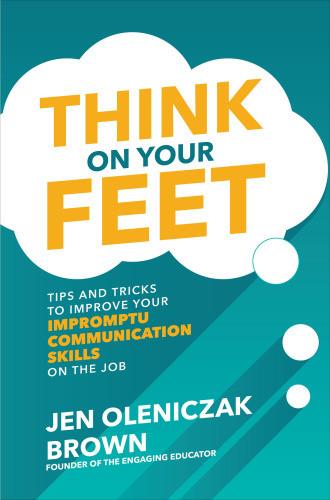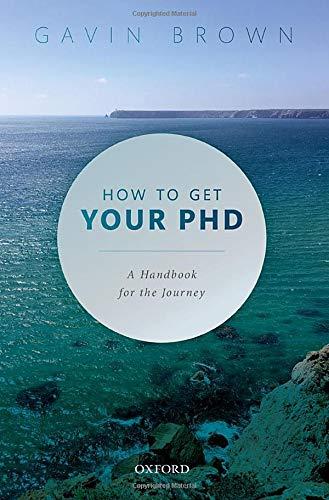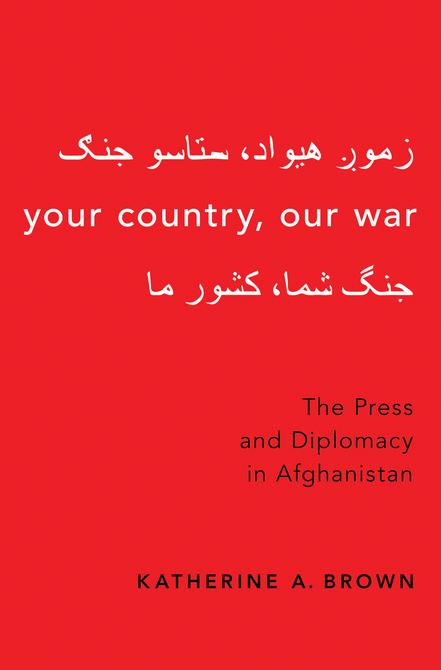Your Country, Our War
The Press and Diplomacy in Afghanistan
KATHERINE A. BROWN
Oxford University Press is a department of the University of Oxford. It furthers the University’s objective of excellence in research, scholarship, and education by publishing worldwide. Oxford is a registered trade mark of Oxford University Press in the UK and certain other countries.
Published in the United States of America by Oxford University Press 198 Madison Avenue, New York, NY 10016, United States of America.
© Oxford University Press 2019
All rights reserved. No part of this publication may be reproduced, stored in a retrieval system, or transmitted, in any form or by any means, without the prior permission in writing of Oxford University Press, or as expressly permitted by law, by license, or under terms agreed with the appropriate reproduction rights organization. Inquiries concerning reproduction outside the scope of the above should be sent to the Rights Department, Oxford University Press, at the address above.
You must not circulate this work in any other form and you must impose this same condition on any acquirer.
Library of Congress Cataloging-in-Publication Data
Names: Brown, Katherine A., author.
Title: Your country, our war : the press and diplomacy in Afghanistan / Katherine A. Brown.
Description: New York, NY, United States of America : Oxford University Press, [2019] | Includes bibliographical references and index.
Identifiers: LCCN 2018031175 (print) | LCCN 2018045038 (ebook) | ISBN 9780190879426 (Updf) | ISBN 9780190879433 (Epub) | ISBN 9780190879419 (pbk. :acid-free paper) | ISBN 9780190879402 (hbk.)
Subjects: LCSH: Afghan War, 2001—Press coverage—United States. | Afghan War, 2001—Press coverage—Afghanistan. | Journalism—Afghanistan—History—21st century. | Press and politics—Afghanistan.
Classification: LCC DS371.4135 (ebook) | LCC DS371.4135 B76 2019 (print) | DDC 958.104/72—dc23
LC record available at https://lccn.loc.gov/2018031175
9 8 7 6 5 4 3 2 1
Paperback printed by Sheridan Books, Inc., United States of America
Hardback printed by Bridgeport National Bindery, Inc., United States of America
For my parents, John and Christine Brown, who gave me the world.
Preface
THE FIRST TIME I met Hamid Karzai was on December 15, 2003. My colleagues from the American embassy and I waited for him in a white, airy tent on the grounds of the Polytechnic University in western Kabul, a few feet away from where 502 delegates gathered for the Constitutional Loya Jirga. The men, and some women, from each of Afghanistan’s 32 provinces were working to forge the country’s first democratic constitution in its 5,000-year history via a massive, grand version of the traditional assembly known as a jirga 1 As an optimistic 25-year-old, I had arrived in Afghanistan a month before to serve as a junior press aide.
The U.S. news media version of Afghanistan depicted a country full of rapid progress after bleak decades of war and fundamentalism. A new constitution was one of the many firsts in Afghanistan that would happen in the next year, including the first paved highway from Kabul to Kandahar, the first presidential election, and the first independent television station. My colleagues and I were eager to continue to pitch these hopeful news stories to the American press. While U.S. embassies’ public affairs officers normally target local press, the Afghan media were so nascent, and the concept of free speech was so foreign, that local journalists looked to their American and other Western counterparts for content and editorial guidance. But by late 2003, the majority of Western broadcast stations had shifted their attention 1,800 miles away to Iraq, the other U.S.-led post-9/ 11 war. With the communications infrastructure still weak in Afghanistan, and no U.S. television reporters stationed in the country, we purchased satellite time so that news anchors in New York could directly interview the Afghan President about the jirga as a historic milestone.
We turned the tent into a miniature, barebones television studio. It was winter in Kabul and we all shivered as we waited for Karzai to arrive. Around 8 p.m., the U.S. east coast 9.5 hours behind, he swept in wearing his signature green and blue striped cape and lamb’s wool hat.
In impeccable English, he spoke excitedly of the day’s deliberations and what that meant for Afghanistan’s future. We guided him to a chair and placed an “IFB” (interruptible foldback) that provided an audio feed into his ear. Then we stood and watched as he spoke to Tom Brokaw of NBC News about the progress taking place in America’s “good war,” which also was already being referred to as a forgotten one.2 Karzai often smiled as he spoke, his rapport with the anchor already firmly established during the previous two years. His tone was easy and relaxed.
To the West, Karzai was a symbol of optimism, unification, and progress—even elegance. Acclaimed fashion designer Tom Ford called him in 2002 “the chicest man on the planet”; Esquire magazine later anointed him one of the best-dressed men in the world, alongside Tom Brady and Jay-Z.3 He was not just a darling of the American government, but also of the American press.
That cold December night was at the top of my mind on October 24, 2016, as I was escorted into Karzai’s residence in the former United Nations compound in the center of Kabul, around the corner from the presidential palace he had occupied for nearly 13 years. It was the same compound where, in 1996, the Taliban castrated former president Mohammad Najibullah Ahmadzai and his brother, and then tied them to trucks and dragged them to their deaths through the streets of Kabul. The same compound that, nearly five years later, hosted a fresh generation of UN employees who believed the new international coalition was accelerating advancement in a country that desperately deserved it.
After passing through three waves of security, where women patted me down and took away all but my notebook and voice recorder, I entered the familiar space. The compound was an oasis from the haze of car exhaust on the streets. Four one-floor buildings lined the perimeter of a lush green courtyard with vibrant rose bushes holding on to the last warmth of the year. Delegations of Afghans from throughout the country walked through the compound daily to see Karzai, to still consult with him about their problems and ask for his help. I passed one delegation, and one of Karzai’s young male assistants escorted me to a waiting room. Two elders from Nangarhar, an eastern province that borders Pakistan, were already there. “She is writing a book,” an aide must have said to them in Pashto as I sat down. The elder closest to me turned and said in English, “You are writing a book!” It was more of a statement than a question, but I nodded anyway.
Preface
After more than a dozen years of traveling to Afghanistan for work and research, I went to Kabul in fall 2016 to finish writing this book. I completed my doctoral dissertation in 2013 on the Afghan, American, and Pakistani news media’s storytelling during the U.S.-led war. I then sat on the research for years, chipping away at rewrites for no more than a couple hours a week. I decided to focus exclusively on the U.S.–Afghan relationship for the book and realized that the nearly four-year pause was necessary to see what had become of the country after the 2014 deadline President Barack Obama had set for American troop withdrawal—and soon after the U.S.-led war entered its sixteenth year on October 7, 2016.
“We are here to talk about Daesh!” the elder proclaimed, using the Arabic term for the Islamic State of Iraq and the Levant (ISIL). Daesh’s activities in Iraq and Syria and its encroachment into Europe and the United States had become the dominant foreign news story in the American press in 2015 and 2016, far surpassing any mention of al Qaeda and/or the Taliban. “You know about Daesh?” he asked me with a smile.
“Yes,” I replied. “I’m an American. We know about Daesh.” I smiled back.
Both of the elders laughed, likely amused that I thought I knew about the apocalyptic death cult they were trying to keep from invading their homes when they weren’t busy trying to keep the Taliban at bay.
Graciously, they insisted I speak with the former president first. I was escorted outside. Karzai was there, waving me over. He had traded his cap and cape for a simple khet partug, the traditional Pashtun dress of a beige flowy tunic and wide-legged pants with a black vest. We walked together to another building, which housed his library. One of his small daughters ran to him and he stopped to introduce me. A lifetime had elapsed between the 2003 Constitutional Loya Jirga and the present day, and he understandably didn’t remember me. I explained briefly who I was, why I had come to Afghanistan in the first place, and why I had requested to see him.
As an administrative aide to President Bush’s National Security Advisor in 2002–2003, I believed in the U.S. mission in Afghanistan and volunteered to be a public affairs assistant at the embassy in Kabul. Unlike the tightly controlled environment of 2016, I was fairly mobile when I lived in the American compound. I traveled to Mazar-e-Sharif, Jalalabad, Kandahar, Kunar, Sheberghan, Bamiyan, and Herat, and I embraced a country seemingly unrivaled in its ability to combine beauty with tragedy. The long history it had with the United States, its centrality to centuries
of great power politics, and the devastation it suffered along the way both fascinated and horrified me. After I stopped working for the U.S. government in late 2004, I sought reasons to return. The chaos and complexity of the place drove many Americans and Westerners from there, mad and frustrated. But for some of us, trying to understand Afghanistan and the region became an addiction, as we felt inexplicably connected to the people and their enduring struggle for a life of peace. We felt we could do something to help.
But this time in 2016, more than any other visit, the city felt starkly different, and the American media’s coverage reflected that. Setbacks in the Afghan economy, its security, its democratic governance, and nationwide respect for human rights—especially for women—were well documented despite a progressive technocrat, Ashraf Ghani, serving as president of a shaky national unity government that was engineered by the United States in 2014. Wazir Akbar Khan—the neighborhood with Karzai’s current compound as well as the presidential palace, U.S. and other Western embassies, and the International Security Assistance Force—was now heavily fortified. I could barely recognize the area; its once familiar buildings were now locked up behind high, armored walls with coils of barbed wire. Some Westerners began to refer to the neighborhood as the “Green Zone,” a term from the U.S.-led Iraq War that meant the space was secured from outside threats. We had never used that term in Kabul before. Nestled in the middle of it was the New York Times house, where I stayed for this trip. I woke up each morning to the sound of helicopters flying overhead. They were moving not troops but U.S. embassy civilians between their offices and the airport—which was only a mile away; the short stretch of road was deemed to be too dangerous to drive. The idea that American officials were living in Afghanistan was only by time zone; more than ever before, the U.S. embassy felt frighteningly isolated.
The deteriorating situation had been reflected in the American media’s shifting portrayal of the country over the years as well as their shifting portrayal of Karzai himself. By the end of his presidency, he too was isolated, rarely leaving the palace grounds, preferring instead that Afghan provincial leaders come to him, as they still do today. He and his country watched nearly 200,000 American soldiers, diplomats, and aid workers who tried to provide security and development support for the country come and go. When security did not improve, when the war dragged on, when corruption worsened, when infrastructure deteriorated, Karzai became
increasingly vocal about his aggravation with his American and other Western partners. By 2009, he began to openly clash with the Obama administration, accusing U.S. officials of interference and hypocrisy. In August 2016, he had told the press that “the Americans, whose primary slogan is democracy, are making a sham of democracy in Afghanistan.”4 He thought that the American free press was also a sham, voicing a belief held by the leaders of many other developing countries: that in the same way the American government has the power to shape the international system, the American news media have the power to fix people’s perceptions of countries that operate within that system. If the country is not a Western one, the image Western journalists often bestow upon it is of a failed and conflict-ridden state.
As we finished our interview, which is the subject of Chapter 1, I thanked him for his time. I explained how a generation of American public servants and aid professionals—my generation, the one that professionally came of age post-9/11—had spent years in the country he once led and how fondly we think of Afghanistan and the Afghan people. I started to stand up, but he gestured for me to sit down. He asked:
But how do the common Americans see Afghanistan? How do they understand Afghanistan? What perception do they have of us? As a violent people? As a people with a history, with a culture, or a people simply with guns and violence? What we see in the Western press . . . it is not the story in Afghanistan, in many ways. We are affected by violence, of course. But we are also a people, a country with weddings, with life, with people meeting. There’s music, there’s culture, there’s history, there’s niceties in life. Do they recognize that? Because the American media has not given that picture to the American people . . . Or has it? Have they? No.
There was sincerity in his voice, a nostalgia for the time when American journalists expressed nothing but respect for his country and his leadership, as Tom Brokaw and so many others had. Years after that cold night in 2003, Karzai would try to dilute the Western media’s portrayal of him as corrupt and his country as backward by discrediting the sources, but the reputation of his country in the West remained as a violent and failed nation.
“No,” I confirmed. “They mostly have not.”5
THIS BOOK IS about the storytelling and framing of modern Afghanistan and of America’s longest war from the perspectives of two nations’ media systems. It reviews how news intersects with international politics and discusses the global power and reach of the U.S. news media, especially within the context of the post-9/11 era. It is based on years of interviews conducted between 2009 and 2017, in Kabul, Washington, and New York. It also draws from two bodies of communications scholarship that are analogous yet rarely linked together. The first is on hegemony and the U.S. news media’s relationship with American society and the government. This includes literature on indexing and cascading; agenda-building and agenda-setting; framing; and conflict reportage. The second is on the American news media’s relationship with the world and how national bias defined as creating and maintaining a shared sense of identity—and ethnocentrism defined as evaluating other people’s cultures according to the standards of one’s own culture—are fixed phenomena in international news. This includes examining the different kinds of press systems that exist globally, and how they interact with each other. In addition, the book examines the sociology of journalism development in Afghanistan since its news media became independent in 2001, and the habits and underlying philosophies its journalists have developed, including their tendency to look to U.S. news to make sense of the volatility, policies, and politics affecting their everyday lives.
It is broken into eight chapters. Chapter 1 acquaints the reader with the impact of the U.S. and Western news media in Afghanistan through the story of how President Hamid Karzai banished New York Times reporter Matthew Rosenberg in August 2014, during the final weeks of his presidency. The chapter uses this story as an entry point to the perceived hegemony U.S. news has in international affairs by foreign actors. It explains how news and nationalism intersect with international politics and introduces the reader to the groundbreaking yet nascent community of Afghan journalists who saw American and other Western journalists as their professional guides.
The second chapter discusses U.S. news reportage in the wake of 9/11 and how certain habits and norms in American national security journalism drove the coverage. It reviews scholarship on the U.S. news media’s relationship with U.S. government and society, especially in the context of international issues and events. The chapter establishes that the foreign policy narrative in Washington is set by a small cohort of U.S. government officials, in addition to international news reporters and editors
for elite news agencies, like the New York Times and Washington Post. Through interviews with U.S. officials and reporters, it also examines the roles the American government and news play in setting the agenda and framing events for the American public and how the U.S. press maintains an ethnocentric bias in its foreign reportage.
The third chapter examines how the American public was reintroduced to Afghanistan after the events of 9/11 and how the U.S. broadcast and print media began to frame “the good war” in October 2001. It analyzes the American news media’s relationship with Afghanistan beginning in the 1980s; the reality it has constructed since 2001 about Afghanistan and the conflict; the waning coverage of Afghanistan during the Iraq War from 2003 to 2009; its increased coverage when President Barack Obama took office in 2009; and its coverage since 2014, as the United States began to prepare to disengage militarily from the country. It also reviews some U.S. officials’ perceptions about their responsibilities to the press. During these 15 years, the news coverage, especially that of the broadcast news media, was tightly indexed to the degree of White House attention to the war and the intensity of conflict for American soldiers. Yet some American print news agencies, especially the Associated Press, New York Times, and Washington Post, have stayed committed to the Afghanistan news story despite decreased American presidential attention.
Having established the attitudes and norms of American national security news, Chapter 4 introduces the reader to the history of the Afghan news media, which was under either authoritarian or hyperpartisan control throughout the 20th century. This chapter explores the political and sociocultural factors that have contributed to the state of modern Afghan journalism, and how Afghan government officials have treated their press since 2001. Through the perspectives of more than 30 elite Afghan journalists, the chapter also examines the habits and norms local journalists have created, in addition to the impact of Western aid money and the presence of Western journalists in the country. The chapter also introduces the reader to the independent news media organizations that have helped to drive dramatic change in Afghan politics and society, often at a seemingly breakneck speed. In sum, it explains the patchwork media landscape of present-day Afghanistan and how it reflects the various power struggles between the country’s politicians, extremists, strongmen, and progressives—and foreign actors.
Chapter 5 describes the various sociological constraints modern Afghan journalists have to work within, not the least of which is a highly volatile
security environment within which they are often targeted with threats, in addition to a high degree of economic instability that jeopardizes their organizations’ sustainability. Based on the interviews, it explores the ways in which they think of themselves, their relationships with Afghan government officials, and their roles in Afghan society. (Some of the journalists were interviewed on the record and are quoted by name, while others— due to Institutional Review Board [IRB] requirements for my dissertation research—were interviewed on background and are not named.) It also surveys the dense networks that Afghan journalists have created with American and other Western journalists to report news stories. Afghan journalists have an inherent national bias and are proud that U.S. elite news professionals find Afghanistan newsworthy as this confers legitimacy on Afghanistan’s importance in the world. Yet given their nascent state, they acknowledged that they depend on Western journalists’ reportage to hold Afghanistan’s powerful accountable.
Chapter 6 focuses on the correspondents in Afghanistan who report for American news agencies, most, but not all, of whom are American. It reflects the views of more than a dozen news professionals who reported for elite news organizations on Afghanistan on how they perceived their roles. (As with the Afghan reporters interviewed, some of them were interviewed on the record, while others were interviewed on background and will not be named.) It discusses their agenda-setting power and their hegemonic role as purveyors of information to their primary and intended audience, Americans, and to the secondary audiences, such as Afghan journalists. The chapter explores these journalists’ relationship with Afghan officials and explores what they believe the future of Afghan journalism will be.
Chapter 7 reviews how Afghan journalists perceive the “reality” journalists for American news organizations have constructed about Afghanistan, and how Afghan journalists make meaning from it. While reporters for U.S.-based news agencies saw Afghanistan through an American, or Western, lens, they rarely had the kind of access to U.S. officials’ secret information that Karzai, and many others, assumed they had. The actual day-to-day mechanics of U.S. press–state relations is embroiled in an infuriating state of mistrust and dysfunction for both parties. Afghan journalists and a majority of Afghan officials assume that U.S. journalists are advocates for the U.S. government’s foreign policies and are sometimes chauvinistically nationalistic, even jingoistic. The U.S. journalists vehemently reject this notion and the suggestion
that their coverage is blindly patriotic. Yet they agree that they are largely aligned with U.S. officials in protecting and advancing America’s general interests abroad. This is natural. The majority of journalists writing for American agencies are American; they have a built-in worldview and sense of identity that is difficult to abandon when they are writing primarily for American audiences. But Afghan journalists also are emotionally affected by the news stories they read that reduce their country to being shattered and hopeless. Consuming U.S. news about Afghanistan can be an affront to their Afghan identity and can inspire intense feelings of nationalism and frustration within them.
WHILE THERE IS a detailed methodology section in Appendix I, there are a few issues I’d like to emphasize about how I constructed this book. First, I chose Afghanistan because of my professional history with the country and my ability to travel there with relative ease. In many ways, not the least of which is the sheer duration of the U.S. government and news media’s engagement in the country, Afghanistan provides an exceptional new case study, a microcosm for press–state relations from two perspectives. While my initial research had included Pakistan as another case study for comparison, I chose to focus solely on the Afghanistan case study because of its richness.
Second, I use “the United States” and “the West” interchangeably. This is because, in Afghanistan especially, the United States is seen as a leader of other Western countries and a creator of liberal international institutions that currently give some structure to global affairs. The Afghan journalists and officials would also speak of the United States and the West interchangeably in their interviews. I also focus on reporters who work for U.S. news agencies, but not all of them are American. This is the case, for instance, with the New York Times’ Carlotta Gall and Associated Press’s Kathy Gannon, who are English and Canadian, respectively. For this reason, when speaking about U.S. correspondents, I sometimes do not simplify them as Americans but as “U.S. journalists” or “U.S. reporters” to indicate that they work for U.S. news agencies.
Third, the qualitative research reflected in the second half of the book focuses on three years in U.S.–Afghan relations and the U.S.-led war: 2010, 2012, and 2016. This corresponds with the years when I conducted my fieldwork in Kabul. My interviews therefore are focused mainly on Afghan and U.S. correspondents who were in Kabul at the same time that I was. I realize this does not cover the entire universe of correspondents, but
I believe the overall sample is strong. Since this research was originally initiated for my doctoral dissertation at Columbia University, it was subject to their IRB processes, which deemed all of the journalists I was interviewing to be vulnerable subjects. As mentioned earlier, all of the interviews from 2010 and 2012 are anonymous and, to curb confusion, I did not give them pseudonyms in the text. My interviews in 2016, and the few I completed from Washington and New York in 2017, were on the record and their names are noted accordingly. Those interviewed in 2016 and 2017 also included U.S. officials. All of them are public officials and gave consent to speak on the record. In addition, because of the permanence of U.S. print bureaus in the country and the parachute nature of broadcast journalism, I conducted few interviews with U.S. broadcast reporters, yet since most Afghan news agencies are broadcast, the strong majority of Afghan journalists I interviewed were broadcasters. Last, I would be remiss if did not acknowledge the limitations of my own identity as an American researcher in Afghanistan as well as the biases journalists may have had toward me because of my nationality, gender, and past professional history as a U.S. government official. While I believe that I captured their unfiltered opinions on the issues I asked about during the interviews, it is not entirely unlikely that they felt they could not be completely candid. Also, to a certain extent, my own research was a sort of parachute journalism. For the sake of this research project, my time in Afghanistan amounted to approximately six months. Collectively, however, I have spent two years in the country over the course of 13 years, which gives me some long-term perspective on the place and the ability to filter out the most salient issues worthy of exploration.
AMERICANS AREN’T THE only ones paying attention to U.S. news about the world; those affected by U.S. foreign policy rarely live within American borders. The people who often care the most about U.S. foreign policy are the government officials, journalists, and publics who are directly affected by the policies created at a distance in Washington. American news has been largely accessible to interested foreign audiences for more than a century, yet technology has accelerated a media boomerang pattern for foreign correspondence: News written abroad for an American audience travels almost instantaneously back to the government officials, journalists, and citizens of the nation U.S. correspondents are talking about.
To most foreign citizens interested in the United States—if not to most Americans—Washington is an intangible place. But a surefire way to get a
sense of a nation and its priorities and worldview is to consume its news. People who speak English and have access to digital media can turn to U.S. news—normally, elite and mainstream agencies—to make their own meaning of U.S. intentions toward their country or region, and to see how America is projecting their country’s image across a global media landscape. While people can use the news of another nation to gain a sort of intelligence about its intentions in the world, it can also provoke strong nationalistic feelings when they see themselves through foreign citizens’ eyes. Contrary to those who hoped that a digital infrastructure would increase two-way flows of respectful dialogue, a greater flow of news and information does not necessarily bring understanding and peace between people and nations. National identity and bias can be maintained and reinforced through their national press, which travels internationally. And news content is both reported and understood ethnocentrically.
In foreign affairs, journalists are not merely observers to a story; they are participants in it. The stories they choose to tell, and how they tell them, can become dominant narratives in global politics. And America’s news narratives provide a national representation. Journalists who report about the world for U.S. news agencies are profoundly important liaisons. In developing countries, they can even be official and unofficial mentors to local press cohorts.
Given the longevity of the U.S. presence in Afghanistan and the Afghan news media’s dramatic proliferation since 2001, Afghanistan provides a fascinating case study for the role of journalists in conflict and diplomacy. By identifying, framing, and relaying narratives that affect the normative environment, U.S. correspondents have played unofficial diplomatic and developmental roles. They have negotiated the meaning of war and peace. Indirectly and directly, they have supported Afghan journalists in their professional growth. The impact they have had on Western public perceptions of the war and in the country’s development have been profound: They did not just provide the first draft of history on this enduring post-9/11 entanglement between the United States and Afghanistan—they actively shaped it.
Acknowledgments
THIS BOOK WAS an exceptionally long project, which I put together in pieces from 2007 to 2018. I have a tremendous amount of people to thank, which I’ll try to do here.
I’m extremely grateful that Angela Chnapko at Oxford University Press saw this book’s potential in 2016, and was so patient with me the last two years as I finished it. Thank you to her and her wonderful production team, including Alexcee Bechthold and Shalini Balakrishnan, who made this process so much easier.
The book began to take shape while I pursued my doctorate at the School of Journalism at Columbia University. I’m forever indebted to the Ph.D. faculty there who pushed me to finish the dissertation and the book, especially Andie Tucher, Todd Gitlin, and Michael Schudson. They were wonderful advisors and editors and, at times, therapists. Thank you, Todd, for encouraging me to focus on Afghanistan for my dissertation research and for regularly challenging me. Thank you also to Brigitte Nacos from Columbia University’s School of International and Public Affairs (SIPA), to Sean Aday from George Washington University, and to Hassan Abbas from the National Defense University who all served on my dissertation committee. I’m also thankful for my fellow cohorts in Columbia’s Communications Ph.D. program and for my colleagues at SIPA, who gave support and friendship over the years: Ruth Palmer, Chris Anderson, Tom Glaisyer, Rasmus Nielsen, Ri Pierce Grove, Julia Sonnevend, Soomin Seo, Gabrielle Oliveira, and Dan McIntyre. And I’ll always be grateful to the late David Klatell, who pushed me to take risks and taught me how to be a better teacher. Deepest thanks as well to Sam Freedman, who taught me how to write and structure a book—and believed in this one’s possibility long before I did.
I feel very lucky to have witnessed firsthand the beauty of life in Afghanistan, beyond the headlines. Thank you to Jen Easterly and Steve
Acknowledgments
Hadley for helping me make the leap from the middle desk to Kabul, and to Mike Hammer for putting me on a career trajectory to make everything happen. Thanks also to Jennifer Betti, Debbie Felix, and Nancy Yuan at The Asia Foundation who helped ensure I had reasons to go back to Afghanistan—and for being wonderful colleagues and friends. And to Shannon Green who gave me residency at the Center for Strategic and International Studies (CSIS) for a brief period and helped me return to Kabul one last time for this book in 2016.
I’m grateful for all of my incredible Kabul colleagues, friends, and housemates over the years, from the U.S. embassy to “Timur’s House”: George Abi-Habib, Maria Abi-Habib, Joan Ablett, Jason Aplon, Kim Barker, Caroline Chung, Shane Christensen, Chris Del Corso, John Dempsey, Bay Fang, Sarah Gordon Gonzales, Jayne Howell, Gelareh Kiazand, Jamshid Mangal, Patt Maney, Siobhan Oat-Judge, Ashley Kushner Orbach, Shirin Pakfar, Farah Pandith, Michelle Parker, Josh Partlow, Jeff Raleigh, Amandine Roche, Matt Rosenberg, Beth Sanzone, Kevin Sieff, Marin Strmecki and Sarah Takesh. Thank you very much to the Afghan journalists and friends who spoke so candidly with me over the years—especially to Bilal Sarwary, Mujib Mashal, Sami Mahdi, Ahmad Mukhtar, and Lotfullah Najafizada. With much gratitude to Saad Mohseni, and all of the other Kabul-, New York, and Washington-based sources for this book who took the time to speak with me.
I’ll never really be able to thank Scott Shadian, who I first met in 2005 and helped me to find ways to return to Kabul multiple times thereafter for research. I’ll be similarly, perpetually indebted to Kay McGowan, the first friend I made in Kabul in 2003, who has looked out for me ever since, no matter where we are in the world.
To friends who read drafts of this book, helped to shape academic papers along the way, and/or helped to identify additional data points and research, thank you very much to: Amelia Arsenault, Kate Bateman, Nicholas Cull, Danny Gaynor, Chris Hensman, Kathryn McGarr, Nick Schifrin, Philip Seib, Jay Wang, Anne Wedner, and Rebecca Zimmerman.
I’m lucky to have had other extraordinary friends in New York, San Francisco, and Washington the last decade who all encouraged me to get this project done despite multiple things getting in the way. Thank you to the inimitable Camille Eiss and Sarah Arkin, who always help me exhale, as do the wonderful Miriam Magdieli, Emily Tavoulareas, Gwen Camp, Rose Jackson, Katherine Maher, Sidney Olinyk, Katherine Finnerty, Shilpa Nadhan, Eguiar Lizundia, Amit Magdieli, Erik Woodhouse, Mike
Masserman, Gordon Griffin, Meredith Gloger, and Lane Edwards. They’ve helped to keep me sane the last couple years in DC. Thanks also to Jenna Arnold, Kim Barker, Lisa Beyer, Reah Johnson Bravo, Dan D’Lauro, Niki Ganz, Tanya Gallo, Jeremy Goldberg, Alex Rossmiller, Jennifer Rosenbaum and Jennifer White who made graduate school life in New York so much easier; and to Chris Anderson, Melanie Bariso, Bill and Julie Coleman, Holly Clune, Rachel Hagen, Karl Rectanus, Mona Rowghani, and Victoria Wheeler for always being such wonderful touchstones, no matter the distance. A special thanks to Dena Lazarova, who convinced me at age 18 that I actually would have a career in international affairs and has been one of my biggest cheerleaders since. And to her daughter, my goddaughter, Gia Lazarova, who will run the world one day.
I also need to add this to the list: My high school loves—Adrienne Sletten, Erin Meyer Krupsaw, Katy Moore, Lindsey Dazel Nichols, Melissa Skrabo Munster, and Robin Remmel Henrich—who’ve always reminded me that California is home.
And I’ll always be grateful to my love, Jim Arkedis, for helping me to cross the finish line.
And thank you to my magnificent family, who’ve encouraged this book and everything I’ve ever done: my sisters, Judy McEntee and Colleen Brown Swan; my brothers-in-law, Dan McEntee and Padraig Swan; my nieces and nephews, Briana and Patrick McEntee, and Saoirse and Sean Brown Swan; my cousins Maria Breber, Chris Carson, Tim Carson, RJ Bannister, Kristen Bannister, Mary Pat Cain Weidner, and their families; and my Aunt Mary and Uncle Tom Carson, who’ve always showed up for me.
Last, to my parents, John and Christine Brown, who’ve passed onto me their curiosity about the world, continue to give me unconditional love and support, and always want to hear my stories: Thank you.
Hamid Karzai vs. the New York Times
We are fully committed to the freedom of the press. It is just to stop the evil in the New York Times’ reporting
aimal faizi, presidential palace spokesman, August 20, 2014, on the expulsion of New York Times reporter Matthew Rosenberg from Afghanistan1
HAMID KARZAI BEGAN nearly every day of his presidency with two books of news clips from his palace press office. One was filled with Western news about Afghanistan; the other was filled with Afghan news reports. He rarely touched the latter.
Karzai was fixated on how Western journalists framed his country, himself, and his family for global audiences. Fairly early into his tenure as president he had become deeply suspicious of American intentions in the country and determined that the elite U.S. press was a channel for the American government. He began to rant about Western, especially American, news coverage in public, believing the media were waging a psychological war against him. He explained in open forums to local reporters that he had studied the American news media and had concluded that U.S. journalists were trying to convince Afghans they would suffer without the U.S.’s sustained financial and military support, which was set to expire at the end of 2014.2
Journalists for American news agencies, Karzai believed, were U.S. government agents. He was first convinced of this in November 2004. At the time, he was in a fierce disagreement with American and British officials over how to counter the increasing proliferation of poppy fields in the country, which narco-traffickers were cultivating into 90 percent of the world’s heroin supply. Poppy was one of the few cash crops Afghanistan’s arid land could produce and it provided a lifeline for the country’s rural
class. But the heroin flooded Europe’s streets. The Americans and British proposed eradicating the supply by spraying the fields from the air, which could efficiently kill vast amounts of crops. Karzai refused to subject his citizens to mass chemicals and pesticides. He said in an October 2016 interview: “The second day of that serious argument between me and the U.S. government, I saw an article in the New York Times accusing my brother of involvement in drug dealing. I thought, ‘How was it that I just had an argument with the American government about this the day before yesterday and a day or two later the New York Times publishes an article saying that my brother was involved with drugs?’ ”3
That November 19, 2004 article, written by Times correspondent Carlotta Gall, who is a British national, reported on the United Nations Office on Drugs and Crime’s (UNODC) conclusion that 321,236 acres of land in all of Afghanistan’s 32 provinces had been planted with poppy in 2004—a 64 percent increase since 2003. The head of the UNODC said that Afghanistan was deteriorating into a “narco-state.”4 Near the bottom of the article, Gall included this line: “Diplomats say there are even reports linking Mr. Karzai’s brother, Ahmed Wali Karzai, an influential figure in the southern city of Kandahar, to the trade.” She also stated that the presidential palace dismissed the allegation as “propaganda” against the president and his brother.
Gall had been hearing news about Ahmed Wali Karzai’s involvement in the drug trade for years. “That wasn’t leaked from the Americans,” she explained in a 2017 interview. When she was writing the article, she had thought, “We should just be saying this,” so she added the allegation into the story. “I shouldn’t have done it like that because the paper regretted it afterwards,” she reflected. “We named people and we should’ve done a more rigorous investigation. But I had known this stuff for years. I actually had very good sources, but I didn’t spell it all out in that piece.”5
The timing, however, was too convenient for President Karzai. He recalled in 2016 that, as a result of that story, “I recognized that either the U.S. press and the U.S. government was working hand in hand in what they deemed to be in the national interest of the United States, or that it was worse than that—and that the press was controlled by and was an arm of U.S. policy vis-à-vis countries like us. And I still hold that second view.”6
After believing for a decade that the U.S. government and the American news industry were united in a cabal that was determined to destabilize Afghanistan and undermine his rule so that the United States could stay
in Afghanistan indefinitely, reading the American press had become all but unbearable.7
The American public, however, the primary audience for U.S. news, had no interest in helping Karzai realize his suspicion. Americans wanted out of Afghanistan. In June 2010, Afghanistan became the U.S.’s longest continuous, modern war with troops actively deployed. By June 2014, Gallup found that 49 percent of Americans thought starting the war was a mistake; in 2002, only 6 percent had. Despite nearly $1 trillion of U.S. taxpayer funds, more than 1 million American troops and diplomats serving in the country, and more than 2,000 dying and 20,000 Americans wounded there, Afghanistan had largely failed to capture America’s imagination.
But in Karzai’s mind, the Western press was writing “the 2014 movie,” an American horror show about a dystopian Afghanistan without Western troops and aid. In 2009, President Barack Obama had created a five-year timeline to end U.S.-led combat operations in the country. For years, American officials had been trying to reach a bilateral security agreement (BSA) that would ensure U.S. troops’ immunity within Afghanistan if they continued to support the fledgling Afghan National Security Forces (ANSF) beyond 2014. Without one, all remaining U.S. ground troops— roughly 16,000 down from a peak of 100,000 in 2010—would leave.8 Karzai believed the United States wanted to stay in a country that bordered Iran, China, Pakistan, and the former Soviet Central Asian states to grow its sphere of influence. He declared publicly that the U.S. news media were working with the U.S. government to intentionally undermine the Afghan people’s faith in their own government and bolster their need for American assistance.9 The U.S. government, he later said in October 2016, “were manufacturing things and telling the press to say things that were not there . . . It was absolute disinformation. It was psychological warfare, launched by the U.S. press.”10
By August 2014, Karzai, physically isolated in a heavily fortified palace in the Wazir Akbar Khan neighborhood of Kabul, deeply suspicious of the Americans, and citing the history of Western powers colonizing Afghanistan, had refused to sign the BSA. He was politically isolated as well: While the two presidential candidates running to succeed him that year, Abdullah Abdullah and Ashraf Ghani, conflicted on many issues, they both emphatically pledged to sign a BSA if elected.
On August 18, the New York Times ran a story by reporter Matthew Rosenberg titled “Amid Election Impasse, Calls in Afghanistan for an Interim Government.”11 It discussed an idea brewing for a temporary
government to bring stability to Kabul and end Abdullah and Ghani’s feud over a deeply flawed election. The stopgap measure, Rosenberg reported, would give the two candidates more time to compromise and perhaps time to sign the BSA before the end-of-2014 deadline. He compared the plans to a “soft coup, though one . . . [that] would later lead to a return to democratic rule” when the final outcome of the election was determined.12
Talk of an interim government was pervasive among the Kabul elites, according to the correspondents in the Times bureau in Kabul at the time. Afghan officials were actively reaching out to them about its potential, seemingly hoping that they would report it so they could gauge American government officials’ reaction to the possibility. The Minister of Interior, Umer Daudzai, and the National Security Advisor to Karzai, Rangin Dadfar Spanta, were quoted on the record in the news story. Rosenberg had filed it in mid-August with his New York-based editor. Yet he was unsure when it would run, not because of any potential controversy, but because Afghanistan wasn’t at the top of the U.S. news agenda. By this time, the war’s 12th summer, political infighting between Afghanistan’s leaders was barely newsworthy.13
To Karzai, the news story was another fabricated rumor, an American government plot designed to sow disruption and destroy Afghanistan’s decade-old democratic experiment. He had determined that it was no longer enough to just make public statements against the U.S. news media in Afghanistan.
A few hours after the story ran on the Times webpage, Rosenberg received a call from the presidential palace’s deputy spokesman. The official asked about the quotation by National Security Advisor Spanta. Having had no complaints from Spanta himself, Rosenberg didn’t think twice about the call. Later, as he was sitting down for lunch, the phone of one of his colleagues rang. It was the Afghan Attorney General’s office, asking Rosenberg to come to his office to meet with “junior officials.” Rosenberg and his colleagues agreed to go later that afternoon.
Upon arriving at the Attorney General’s office, which was just minutes from their office by car, Rosenberg and his two colleagues were taken to a conference room with General Noorullah, the senior prosecutor and the general director of the Crimes Against External and Internal Security unit. At first, the tone was friendly. They requested the names of Rosenberg’s sources; while Daudzai and Spanta had been quoted on the record, Rosenberg quoted other Afghan officials anonymously. He refused to
name his sources. The mood changed. The meeting continued for a tense two hours. Eventually, the Afghan officials presented Rosenberg with a piece of paper with writing in the Dari language and requested he sign it. Rosenberg exchanged glances with his colleagues, and then said he would return with a lawyer. The Afghan officials allowed him to walk out of the ministry.
As they were returning to the Times bureau, a tweet by Tolo News, Afghanistan’s most popular news agency, delivered the message that the Afghan officials didn’t deliver to their faces. “BREAKING,” the tweet read. “Afghan Att. Gen. bans Matt Rosenberg of the NYTimes from leaving the country b/c of a controversial story.”14 News quickly spread through the small journalism community in Kabul. Minutes later, the Associated Press called Rosenberg to try to confirm the report.
Rosenberg called his parents to explain the situation before they would have to read about it and to assure them he was safe. As far as he knew, he would be: The Afghan Media Law, enacted in 2009, protected him from imprisonment. The story was also multisourced and sound. Times editor Doug Schorzman later explained in a 2016 interview, “We had every reason to believe that this was a serious thing going on. It was not predictive. It was a serious discussion of an emergency government and we cross referenced it in a serious way.”15 Rosenberg’s Kabul bureau colleague Rod Nordland also agreed that “It was an important story and it was a true story.”16
That night, Nordland published a piece about Rosenberg’s interdiction, the first known one of a Western journalist by the Afghan government since the overthrow of the Taliban. The story, “Afghan Officials Interrogate a Times Correspondent,” included a quote from Adela Raz, the deputy spokeswoman for President Karzai. He said:
Such baseless reports by the New York Times are in violation of all the recognized principles of journalism, or they are politically motivated. Since the beginning of the [2014] presidential election the New York Times newspaper has sought to sow disunity among the Afghans by publishing several reports of this nature. We have notified the administration of the newspaper in writing several times about the publication of reports that encourage disunity, but they have repeatedly published such reports, and therefore we must take serious action in accordance with appropriate Afghan law.17
